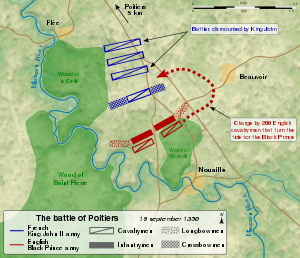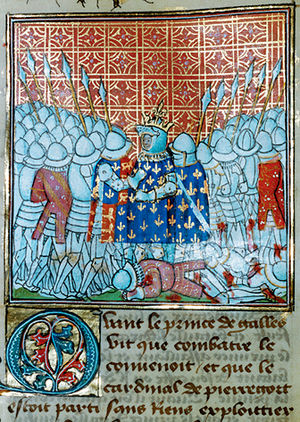In early 1356, the Duke of Lancaster led an army through Normandy, while Edward led his army on a great chevauchée from Bordeaux on 8 August 1356.[6]
Edward’s forces met little resistance, sacking numerous settlements, until they reached the Loire River at Tours. They were unable to take the castle or burn the town due to a heavy rainstorm. This delay allowed King John II to attempt to pin down and destroy Edward’s army. John, who had been besieging Breteuil in Normandy, organised the bulk of his army at Chartres to the north of Tours. In order to increase the speed of his army’s march, he dismissed between 15,000 and 20,000 of his lower quality infantry, just as Edward turned back to Bordeaux.[7] The French rode hard and cut in front of the English army, crossing the bridge over the Vienne at Chauvigny. Learning of this, the Black Prince quickly moved his army south. Historians disagree over whether the outnumbered English commander was seeking battle or trying to avoid it.[8] In any case, after preliminary maneuvers and failed negotiations for a truce, the two armies faced off, both ready for battle, near Poitiers on Monday, 19 September 1356.
Edward arrayed his army in a defensive posture among the hedges and orchards of the area, in front of the forest of Nouaillé. He deployed his front line of longbowmen behind a particularly prominent thick hedge, through which the road ran at right angles. The Earl of Douglas, commanding the Scottish division in the French army, advised King John that the attack should be delivered on foot, with horses being particularly vulnerable to English arrows. John heeded this advice, his army leaving its baggage behind and forming up on foot in front of the English. The English gained vantage points on the natural high ground in order for their longbowmen to have an advantage on the heavily armored French troops.[citation needed]
The English army was led by Edward, the Black Prince and composed primarily of English and Welsh troops, though there was a large contingent of Gascon and Breton soldiers with the army. Edward’s army consisted of approximately 2,000 longbowmen, 3,000 men-at-arms and a force of 1,000 Gascon infantry.
Like the earlier engagement at Crécy, the power of the English army lay in the longbow, a tall, thick self-bow made of yew. Longbows had demonstrated their effectiveness against massed infantry and cavalry in several battles, such as Falkirk in 1298, Halidon Hill in 1333 and Crécy ten years prior, in 1346. Poitiers was the second of three major English victories of the Hundred Years’ War attributed to the longbow, though its effectiveness against armoured French knights and men-at-arms has been disputed.[9][10][11]
Geoffrey the Baker wrote that the English archers under the earl of Salisbury “made their arrows prevail over the [French] knights’ armor,”[12] but the bowmen on the other flank, under Warwick, were initially ineffective against the mounted French men-at-arms who enjoyed the double protection of steel plate armor and large leather shields.[13]Once Warwick’s archers redeployed to a position where they could hit the unarmored sides and backs of the horses, however, they quickly routed the cavalry force opposing them. The archers were also unquestionably effective against common infantry, who did not have the wealth to afford plate armour.[14][15]
The English army was an experienced force; many archers were veterans of the earlier Battle of Crécy, and two of the key commanders, Sir John Chandos, and Captal de Buch were both experienced soldiers. The English army’s divisions were led by Edward, the Black Prince, the Earl of Warwick, the Earl of Salisbury, Sir John Chandos and Captal de Buch.
The French army was led by John II of France, and was composed largely of native French soldiers, though there was a contingent of German knights, and a large force of Scottish soldiers. The latter force was led by the Earl of Douglas and fought in the King’s own division.[16] The French army at the battle comprised approximately 8,000 men-at-arms and 3,000 common infantry, though John had made the decision to leave behind the vast majority of his infantry, numbering up to 20,000, in order to overtake and force the English to battle.
The French army was arrayed in three “battles” or divisions; the vanguard was led by the Dauphin Charles, the second by the Duke of Orléans, while the third, the largest, was led by the King himself.
Prior to the battle, the local prelate, Cardinal Hélie de Talleyrand-Périgord attempted to broker a truce between the two sides, as recorded in the writings of the English commander, Sir John Chandos.[17] Attending the conference on the French side was John II of France, the Count of Tankerville, the Archbishop of Sens and Jean de Talaru. Representing the English was the Earl of Warwick, the Earl of Suffolk, Bartholomew de Burghersh, James Audleyand Sir John Chandos. The English offered to hand over all of the war booty they had taken on their raids throughout France, as well as a seven-year truce. John, who believed his force could easily overwhelm the English, declined their proposal. John’s counter suggestion that the Black Prince and his army should surrender was flatly rejected.
At the start of the battle, the English removed their baggage trainfrom the field, prompting a hasty French assault, believing that what they saw was the English retreating.[18] The fighting began with a charge by a forlorn hope of 300 German knights, led by Jean de Clermont. The attack was a disaster, with many of the knights shot down or killed by English soldiery. According to Froissart, the English archers then shot their bows at the massed French infantry.[19] The Dauphin’s division reached the English line. Exhausted by a long march in heavy equipment and harassed by the hail of arrows, the division was repulsed after approximately two hours of combat.[20]
The retreating vanguard collided with the advancing division of the Duke of Orléans, throwing the French army into chaos. Seeing the Dauphin’s troops falling back, Orléans’ division fell back in confusion. The third, and strongest, division led by the King advanced forth, and the two withdrawing divisions coalesced and resumed their advance against the English. Believing that the retreat of the first two French divisions marked the withdrawal of the French, Edward had ordered a force under Captal de Buch to pursue. Sir John Chandos urged the Prince to launch this force upon the main body of the French army under the King. Seizing upon this idea, Edward ordered all his men-at-arms and knights to mount for the charge, while de Buch’s men, already mounted, were instructed to advance around the French left flank and rear.[21]
As the French advanced, the English launched their charge. Stunned by the attack, the impetus carried the English and Gascon forces right into the French line. Simultaneously, de Buch’s mobile reserve of mounted troops fell upon the French left flank and rear. Fearful of encirclement, the cohesion of the French army disintegrated as many soldiers attempted to flee the field. Low on arrows, the English and Welsh archers abandoned their bows and ran forward to join the melée. Around this time, King John and his son, Philip the Bold, found themselves surrounded. As written by Froissart, an exiled French knight fighting with the English, Sir Denis Morbeke of Artois approached the king, requesting the King’s surrender. The King is said to have replied, “To whom shall I yield me? Where is my cousin the Prince of Wales? If I might see him, I would speak with him”. Denis replied; “Sir, he is not here; but yield you to me and I shall bring you to him”. The king handed him his right gauntlet, saying; “I yield me to you”.[22]
Following the surrender of the King and his son Philip, the French army had broken up and left the field, ending the battle.[citation needed]
Following the battle, Edward resumed his march back to the English stronghold at Bordeaux. Jean de Venette, a Carmelite friar, vividly describes the chaos that ensued following the battle. The demise of the French nobility at the battle, only ten years from the catastrophe at Crécy, threw the kingdom into chaos. The realm was left in the hands of the Dauphin Charles, who faced popular rebellion across the kingdom in the wake of the defeat. Jean writes that the French nobles brutally repressed the rebellions, robbing, despoiling and pillaging the peasants’ goods. Mercenary companies hired by both sides added to the destruction, who plundered the peasants and churches.[23]
Charles, to the misery of the French peasantry, began to raise additional funds to pay for the ransom of his father, and to continue the war effort. Capitalising on the discontent in France, King Edward assembled his army at Calais in 1359 and led his army on a campaign against Rheims. Unable to take Rheims or the French capital, Paris, Edward moved his army to Chartres. Later, the Dauphin Charles offered to open negotiations, and Edward agreed.[citation needed]
The Treaty of Brétigny was ratified on 24 October 1360, ending the Edwardian phase of the Hundred Years’ War. In it, Edward agreed to renounce his claims to the French throne, in exchange for full sovereign rights over an expanded Aquitaine and Calais, essentially restoring the former Angevin Empire.[24]


